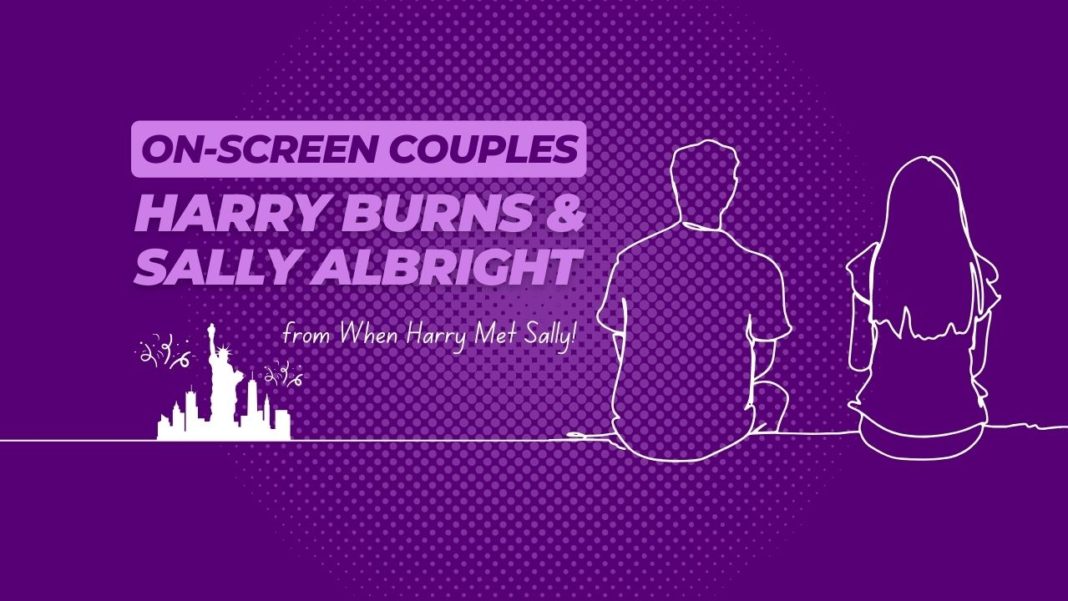When Harry Met Sally is a landmark film in the romantic comedy genre, directed by Rob Reiner and written by Nora Ephron. Released in 1989, it stars Billy Crystal as Harry Burns and Meg Ryan as Sally Albright, two New Yorkers who share a serendipitous ride to the city from Chicago upon graduating from university. This encounter kicks off a series of meetings over the years that eventually lead to a deep friendship and more, providing the film with its central plot.
its central plot.
The film is renowned not only for its witty dialogue and the palpable chemistry between its leads but also for posing a provocative question that drives the narrative: Can men and women ever just be friends? This question serves as the philosophical backbone of the movie, challenging societal norms about male-female relationships and setting the stage for a deep exploration of love, friendship, and everything in between. Through Harry and Sally’s evolving relationship, the film invites viewers to ponder this question in the context of their own experiences and beliefs.
Setting the Scene
The initial meeting between Harry and Sally occurs in 1977 when they share a car ride from the University of Chicago to New York City, each embarking on a new phase of their adult lives. During this lengthy drive, their conversation quickly delves into personal beliefs and philosophies, especially about relationships. Harry, with his straightforward and somewhat cynical outlook, asserts that men and women can’t be friends because “the sex part always gets in the way.” Sally, on the other hand, is more optimistic and disagrees, believing in the possibility of a platonic friendship between men and women.
This car ride sets the tone for their complex relationship over the next 12 years. They part ways with differing viewpoints, only to unexpectedly reunite multiple times. Each encounter reveals subtle shifts in their personal lives and attitudes towards relationships. For instance, when they meet again five years later in an airport, both are involved with other people and their brief conversation underscores how their lives have diverged yet still intersect.
Their friendship truly begins another five years later when they chance upon each other at a bookstore. By then, both are recovering from significant breakups, making them more open to forming a new kind of relationship. From this point, they cultivate a close friendship based on shared experiences and emotional support, which marks a new chapter in their interactions, highlighting a shift from their initial skepticism about cross-gender friendships to a real, supportive bond.
Key moments that illustrate further changes in their perceptions include their discussions about their past relationships and dating experiences, their comforting each other through emotional distress, and their attempt to set each other up with their respective best friends, which comically backfires, bringing them even closer. Each of these instances not only strengthens their connection but also redefines their understanding of what men and women can be to each other, gradually building towards a deep, albeit complicated, love.
Character Analysis
Harry Burns
Harry Burns starts the film as a somewhat cynical young man who firmly believes that men and women cannot maintain a platonic friendship due to inevitable sexual attraction. His views are initially portrayed through humorous yet skeptical dialogues that challenge the more idealistic perspectives of Sally. Harry’s character is a blend of sharp wit and realism, often using humour to shield himself from deeper emotional engagement.
Key Scenes Highlighting Harry’s Evolution
Initial Car Ride to New York
This scene is pivotal as it introduces Harry’s belief that sexual attraction will always interfere in cross-gender friendships. His argument sets the stage for the film’s central question and his own journey. His dialogue is witty but reveals his pessimistic view on relationships, which is contrasted by Sally’s more naive outlook.
Split-Screen Call and Watching TV
Years after their first meeting, Harry and Sally watch the same movie from their respective beds while on the phone. This scene shows Harry’s wit as they banter, but it also subtly indicates his growing comfort with having Sally in his life in a non-romantic capacity. This marks a shift in his understanding of platonic relationships.
The Break-Up Scene
After both suffer from painful breakups, Harry genuinely comforts Sally. This scene is crucial as it showcases Harry’s capacity for empathy and deep emotional connection, traits that were not apparent in his earlier cynicism. His ability to be there for Sally without ulterior motives redefines his character’s emotional depth.
New Year’s Eve Revelation
In one of the film’s climactic moments, Harry rushes to find Sally at a New Year’s Eve party. His monologue, where he lists the quirks and details he loves about Sally, highlights his complete transformation. He recognises and embraces the deep emotional connection he has with Sally, signifying his growth from a cynic to a man who values and seeks out meaningful relationships.
Harry’s journey in When Harry Met Sally reflects a significant transformation from a man who dismisses close friendships with women to one who realises that such relationships can be the deepest and most fulfilling. His character evolution is not just about falling in love with Sally but also about understanding the nuances and depths of human connections beyond initial prejudices. This progression is poignantly encapsulated in the film’s resolution, where Harry integrates his wit and newfound emotional depth to embrace a mature, loving relationship with Sally.
Sally Albright
Sally Albright, portrayed by Meg Ryan, begins her journey in When Harry Met Sally as an optimistic and idealistic young woman with clear-cut views on relationships and friendships. Unlike Harry, she believes that men and women can be just friends without romantic complications. This belief frames her as the more pragmatic and emotionally controlled counterpart to Harry’s cynical and spontaneous personality.
Key Moments Showcasing Sally’s Personality and Emotional Journey
Initial Car Ride to New York
From their first interaction, Sally is shown as methodical and optimistic. She confidently disagrees with Harry’s perspective on male-female friendships, believing instead in platonic relationships. This scene sets her up as a foil to Harry’s more jaded view of relationships, highlighting her hopeful outlook.
“Casual” Dinner Scene
As their friendship develops, Sally and Harry have dinner where they discuss the nuances of dating in their 30s. Sally’s methodical approach to life is evident when she explains her system for dating and what she desires in a relationship, portraying her as someone who likes to have control and predictability in her life.
The “I’ll Have What She’s Having” Scene
This iconic scene at Katz’s Delicatessen not only provides comedic relief but also sheds light on Sally’s comfort with her sexuality and her willingness to challenge societal norms openly. It’s a pivotal moment that shows her boldness and complexity, contrasting Harry’s more reserved and traditional behavior.
Processing Her Break-Up
Sally’s reaction to her break-up is a significant turning point in her emotional journey. Her breakdown in front of Harry, where she expresses her fears and vulnerabilities about being alone, reveals layers of her personality that were masked by her usual composure. This moment deepens her character, showing her not just as optimistic and controlled but also as deeply emotional and human.
New Year’s Eve Realisation
Sally’s emotional climax at the New Year’s Eve party, where she confronts Harry about his declaration of love, encapsulates her growth. She’s initially resistant, reflecting her fear of ruining their friendship and her desire for emotional safety. However, her eventual acceptance of Harry’s love and her own feelings for him illustrates her journey from a controlled, pragmatic romantic to someone willing to take emotional risks for true happiness.
Sally Albright’s character evolution in When Harry Met Sally is marked by her journey from a young woman with a somewhat naive and controlled approach to relationships to a more mature individual who embraces the complexities of love and friendship. Her interactions with Harry not only provide a contrast to his personality but also facilitate a deeper exploration of what it means to love and be loved, challenging her initial beliefs and leading to significant personal growth.
Iconic Moments and Dialogues
When Harry Met Sally has left a lasting imprint on the romantic comedy genre through its memorable scenes and sharp dialogues that blend humour with profound emotional truths. Two scenes, in particular, stand out not only for their entertainment value but also for their impact on how romantic relationships are portrayed in cinema.
The “I’ll Have What She’s Having” Scene
Set in Katz’s Delicatessen, this scene features Sally reacting to Harry’s skepticism about women’s experiences of pleasure. In a humorous display, Sally fakes a loud, convincing display of pleasure, shocking the patrons and leaving Harry embarrassed. This scene concludes with an older woman (played by the director’s mother) humorously remarking to the waiter, “I’ll have what she’s having.” This moment is not just iconic for its humour but also for its bold approach to discussing female sexuality openly in a comedic setting, which was relatively progressive at the time. It challenges and entertains, making it a pivotal moment in the film and a frequently referenced scene in popular culture.
The New Year’s Eve Conversation
The emotional climax of the film occurs at a New Year’s Eve party. After realising his deep feelings for Sally, Harry rushes to the party to confess his love. His speech, where he lists the quirks and details he loves about Sally, “I love that it takes you an hour and a half to order a sandwich, I love that you get a little crinkle above your nose when you’re looking at me like I’m nuts,” encapsulates the essence of true companionship and love. This heartfelt declaration shifts the film from a witty exploration of male-female friendships to a deeper acknowledgment of love founded on understanding and accepting one another’s flaws.
Contribution to the Film’s Popularity and Genre Influence
These scenes contribute significantly to the film’s enduring popularity by blending humour with relatable, genuine emotions, making the characters’ experiences feel real and impactful. The deli scene, in particular, broke new ground by bringing a female perspective on sexual satisfaction into the public discourse in a humorous way, pushing the boundaries of romantic comedy narratives.
The New Year’s Eve scene, meanwhile, has become a blueprint for romantic declarations in film. It emphasises that true love often lies in appreciating the minutiae of one’s partner, an idea that has since been mirrored in countless romantic comedies. This scene has helped cement the idea in popular culture that love involves both grand romantic gestures and the quiet appreciation of everyday moments.
These iconic moments not only define When Harry Met Sally as a pivotal work in its genre but also continue to influence how relationships are depicted in films today. They offer a blend of comedy and heartfelt emotion that resonates with audiences, making the film a timeless piece in the landscape of romantic comedies.
Themes and Messages
When Harry Met Sally intricately explores several universal themes through the evolving relationship between its title characters. These themes, particularly the concepts of love, friendship, and the nature of intimacy, are woven into the fabric of the narrative, providing depth and resonance that extend beyond the surface-level comedy.
Themes Explored
Love and its Evolution
The film examines how love can evolve from friendship, suggesting that the strongest relationships might be those that are rooted in a deep, platonic bond before transitioning into romance. Harry and Sally’s relationship serves as a case study for this theory, as they transition from acquaintances to friends, and eventually to lovers. This progression challenges the conventional romantic plot trajectory of immediate attraction, offering instead a portrayal of love as something that grows over time, grounded in mutual respect and understanding.
Friendship Between Men and Women
Central to the narrative is the question of whether men and women can be just friends. The film presents a dynamic exploration of this theme through Harry and Sally’s differing opinions and the evolution of their relationship. While Harry initially asserts that sexual attraction makes platonic friendship impossible, Sally’s presence in his life and their eventual romantic relationship suggest a more complex reality. The film proposes that while such friendships can be complicated by romantic feelings, they are indeed possible and can lead to a more profound connection.
Intimacy Beyond the Physical
Intimacy in When Harry Met Sally is portrayed not just in romantic or physical terms but also through the characters’ ability to share their deepest fears, hopes, and idiosyncrasies. The film highlights emotional and intellectual intimacy as foundational to their relationship, suggesting that true intimacy involves knowing and loving everything about another person, including their flaws.
Challenging Societal Norms
The film was somewhat revolutionary in its portrayal of male-female relationships, challenging the societal norms of the late 1980s. At a time when romantic comedies often relegated women to the role of love interests or objects of pursuit, Sally is portrayed as an independent, complex character whose thoughts and feelings are given as much importance as Harry’s.
By ending with Harry and Sally together, the film suggests that friendships between men and women can include elements of sexual attraction and still be genuine and enduring. This was a significant departure from the typical narratives of the time, which often avoided exploring the complexities of such relationships.
The exploration of themes like what constitutes a meaningful relationship and how people understand and express their needs in relationships pushed the boundaries of the genre. It invited audiences to reconsider their own views on love and friendship, making the film not only entertaining but also thought-provoking.
When Harry Met Sally remains a culturally significant film because of its thoughtful examination of these themes. Its nuanced take on relationships continues to inspire and influence discussions about the nature of love and friendship today.
Cultural Impact and Legacy
When Harry Met Sally has not only enjoyed immense popularity but has also had a profound impact on popular culture and the romantic comedy genre. Its innovative narrative structure, character development, and memorable dialogues have set new standards in filmmaking, influencing countless films and media productions.
Impact on the Romantic Comedy Genre
Genre Transformation
Prior to When Harry Met Sally, many romantic comedies focused predominantly on the pursuit of love, often culminating in the characters falling in love. This film shifted the focus towards the complexities of relationships, exploring themes of friendship, love, and the blurred lines between them. It championed the idea of friends becoming lovers as a trope, which has since become a staple in romantic comedies.
Dialogue and Realism
The film is renowned for its witty, sharp dialogue that resonates with real-life conversations. Nora Ephron’s screenplay, filled with humour and emotional depth, redefined what dialogues in romantic comedies could sound like, influencing how characters in subsequent films would speak and interact.
Character Development
The detailed character arcs of Harry and Sally set a new standard for character development in romantic comedies. They are fully realised individuals, each with distinct personalities and growth, which allows the audience to invest more deeply in their journey together. This focus on character depth has encouraged more nuanced and layered portrayals in the genre.
References and Influence in Other Media
Cultural References
The “I’ll have what she’s having” scene has been parodied and referenced in numerous films, television shows, and other media forms, attesting to its iconic status. This line itself has become a popular cultural reference, often used to denote moments of envy or approval in various contexts.
Inspirations
When Harry Met Sally has inspired a range of other works that explore male-female friendships and the potential for romance. It is frequently cited by filmmakers and screenwriters as a benchmark for creating engaging, relatable romantic comedies.
Academic and Critical Acclaim
The film is often discussed in academic settings, particularly in film and gender studies, for its exploration of relationships and social norms. Critics continue to laud it for its balance of humour and heart, with many considering it a gold standard for the genre.
Status as a Beloved Classic
When Harry Met Sally holds a cherished place in American cinema. It’s not only a favourite for casual viewing but also a frequent feature in film festivals and retrospectives dedicated to classic films and romantic comedies. Its annual re-watch value, especially during New Year’s Eve, underscores its status as a timeless classic that continues to resonate with audiences across different generations.
The legacy of When Harry Met Sally is evident in its enduring appeal and its influence on romantic comedies that strive to replicate its witty dialogue, realistic portrayal of relationships, and emotional depth. The film’s cultural impact is a testament to its quality, relevance, and the universal appeal of its central themes.
Modern Relevance
When Harry Met Sally continues to resonate with contemporary audiences, its themes and relationship dynamics proving timeless despite the evolving social and cultural landscape. However, the way modern viewers interpret the film’s central question and character interactions might differ significantly from how audiences perceived them at the time of the film’s release.
Contemporary Resonance of Relationship Dynamics
Friendship and Romance
The blurred lines between friendship and romance depicted in the film remain relevant, as modern relationships often defy traditional labels and progress in non-linear ways. The portrayal of Harry and Sally’s relationship, which evolves from acquaintance to friendship to love, mirrors current trends where relationships are not rushed but are built on strong foundations of mutual respect and understanding.
Communication and Emotional Honesty
Today’s audiences may particularly appreciate the film’s emphasis on communication and emotional honesty. The candid discussions Harry and Sally have about their feelings, fears, and desires reflect a modern approach to relationships, where open communication is often seen as key to compatibility and lasting connection.
The Central Question: Can Men and Women Be Just Friends?
Shift in Gender Dynamics
When the film was released, the idea that men and women could be friends without romantic interference was more controversial. Today, with changing gender norms and a greater understanding of diverse sexualities and relationship structures, the question might seem outdated to some. Contemporary views often accept that friendships can exist across genders without sexual or romantic implications, acknowledging the complexity of human relationships beyond heterosexual norms.
Modern Interpretations
Modern audiences might interpret Harry and Sally’s eventual romantic relationship not as an inevitability of cross-gender friendship but as one possible outcome among many. The film can be seen as exploring the idea that friendship is a valid form of love on its own and can be the foundation for romantic love if both parties are willing and interested.
Impact of Social Media and Digital Communication
Changing Relationship Dynamics
With the advent of social media and digital communication, the way people form and maintain relationships has changed drastically since the late ’80s. This shift might lead contemporary viewers to reflect on how Harry and Sally’s relationship might have differed in the digital age, where constant connectivity and online dating have transformed how relationships start and develop.
While the core dynamics of When Harry Met Sally continue to engage audiences, modern interpretations tend to focus more on the nuances of the characters’ relationship rather than the binary question of whether men and women can be friends. The film’s exploration of friendship, love, and the spaces in between remains poignant and relevant, offering rich material for discussion about the nature of relationships in any era.
Conclusion
The enduring appeal of Harry and Sally’s story in When Harry Met Sally lies in its authentic and nuanced portrayal of human relationships. Through the evolution of Harry and Sally from strangers to friends to lovers, the film captures the intricacies of love and friendship with humour, warmth, and a depth that resonates across generations.
Enduring Appeal
Relatability and Realism: The film’s strength is its relatability. Audiences see parts of their own lives in Harry and Sally’s conversations, their disagreements, and their growth both together and apart. The film does not shy away from the messiness and unpredictability of relationships but embraces these aspects as fundamental to its charm and truthfulness.
Wit and Wisdom: The screenplay, rich with witty banter and poignant reflections on love, has etched itself into the cultural lexicon. The humour is intelligent and situational, deriving from everyday scenarios that viewers find familiar and engaging.
Lessons on Love and Friendship
Foundation of Friendship: One of the key messages of the film is the value of building a relationship on a foundation of friendship. Harry and Sally’s story suggests that a deep understanding and appreciation of another person, developed through genuine friendship, can lead to a fulfilling romantic relationship.
Complexities of Human Connections: The film explores how relationships are not defined by a single moment but are the sum of shared experiences, challenges, and mutual growth. It shows that love is not just about grand gestures but about the small, everyday acts of kindness and understanding that accumulate over time.
Reflection on Human Connections
When Harry Met Sally teaches us that human connections are complex and multifaceted. It challenges the notion that relationships must follow a predetermined path and instead celebrates the unique and often unpredictable ways in which people come together. The film underscores the importance of patience, communication, and emotional honesty, illustrating how these qualities can deepen relationships and make them more meaningful.
Ultimately, the story of Harry and Sally endures because it does not provide simple answers but instead reflects the beautiful complexities of life and love. It reminds us that while the path of relationships may be unpredictable, it is these very uncertainties that make the journey worthwhile.






